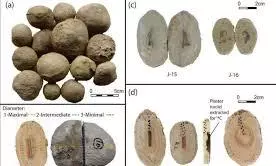
Ancient pottery and rare cave pearls unearthed in Jerusalem's historic tunnel
text_fieldsResearchers from the Hebrew University of Jerusalem have uncovered 50 rare cave pearls within the Joweizeh Spring Tunnel, a historic water system near Jerusalem's Old City.
Led by Dr. Azriel Yechezkel, the team also found 14 pearls containing pottery fragments and two with plaster remains, marking the first recorded case of man-made objects embedded in such formations. The findings were published in the journal Archaeometry.
Cave pearls are small, spherical mineral formations that require precise environmental conditions to form, making them a rare speleothem. Unlike many geological structures, they can develop in as little as a few hundred years. The sealed section of the Joweizeh Spring Tunnel provided the ideal environment for these pearls to form.
The pearls, discovered in various sizes, underwent compositional analysis. Pottery shards embedded within the pearls were linked to the Hellenistic, Roman, and Byzantine periods, with some fragments dating as far back as the Iron Age and Middle Bronze Age. Interestingly, a few pottery pieces featured a cobalt-rich coating, indicating origins in regions like Cyprus and Ephesus.
The Joweizeh Spring Tunnel, a 232-meter-long waterway, is one of the oldest artificial water systems in the southern Levant. Originally constructed during the Iron Age II as part of a royal estate, it was used extensively across the Persian, Hellenistic, Roman, and Byzantine eras. Significant renovations were undertaken during the Hellenistic period, highlighting its enduring importance.
Dr. Yechezkel suggested that some of the imported pottery, potentially a ceramic lamp, may have been used by engineers overseeing the tunnel's construction. The discovery offers insights into ancient engineering practices and water management techniques.
This unique find demonstrates the interplay between natural processes and human intervention. The embedding of pottery fragments and plaster within the cave pearls is an unprecedented phenomenon, underscoring the tunnel's dual significance as both a natural and historical marvel.

















